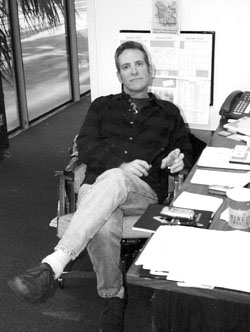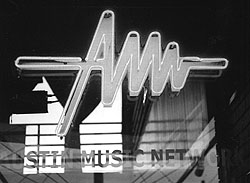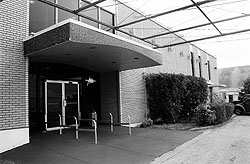|  (A
Funny Thing Happened On) The Road To Rock Stardom (A
Funny Thing Happened On) The Road To Rock Stardom
Louis Meyers
by Tammy
Moore
I’ve
said it before, and I’ll say it again…Austin is
one of the coolest places in the world to live. Do we or do
we not have a music scene here that rivals the best of them?
Do we or do we not have some of the greatest musical talents
in the world within our reach seven nights a week? And how
many cities can boast that they have their own music television
station to showcase all that talent? Today, I want to introduce
you to the man who is making the Austin Music Network more
visible than ever, despite the fact that its budget has been
cut by half a million dollars in the past year. His name is
Louis J. Meyers, and when you read his story, it won’t
surprise you too much that AMN is holding steady on this seasoned
industry veteran’s watch.
Born
and raised in Austin, Texas, Meyers is a skilled player of
the guitar, steel guitar and banjo. He was turned on to music
as a kid in the early ‘60s when his older brother, Larry,
who was considered the top lead guitar player in Austin then,
and his band would rehearse at the Meyers’ home each
weekend. Meyers formed his own first band at the age of 6,
and here’s why: There was a guitar teacher in those
days named Wayne Woods who taught everyone from Eric Johnson
to, well, “everybody that grew up here in the ‘60s.”
according to Meyers. And if you had a band, on Saturdays,
Woods would hold a workshop where you could bring the entire
band in, and he would teach the band a song. He would instruct
each member on their individual part, and by the time class
was over, your band walked out able to play a somewhat arranged
and rehearsed song. It was an amazing feeling. When the band
of youngsters staged a lunchtime concert in the elementary
school cafeteria one day belting out “Gloria”
and “I Fought The Law and The Law Won,” and it
was well received by their classmates. Meyers knew exactly
what he wanted to do with his life.
Meyers went on to play in bands all through high school. He
was one of the youngest members of the ‘cosmic cowboy
scare’ scene in the ‘70s where he played alongside
the likes of Rusty Weir and Jerry Jeff Walker. Those artists
were older than Meyers, but Weir liked him and took on the
role of mentor to the young musician. After high school, he
enrolled in the first commercial music program available in
the States at the Thompson School of Country Music in Claremore,
Oklahoma. He stayed there for three years, two as a student
and one as an instructor. None other than Junior Brown took
Meyers’ place when he decided it was time for a change.
Meyers
left to tour with Bill and Bonnie Hearne and recorded their
first album with them. His travels with the group landed him
in Fayetteville, Arkansas. He fell in love with that city
overnight and decided to stay. It was there that he started
playing with bluegrass wonders Boy Howdy and The Other Brothers.
Shortly after, he found himself on a stage in East St. Louis,
Illinois. After catching a glimpse of himself in the mirror
there doing a cover of Pat Benatar’s “Hit Me with
Your Best Shot,” sporting an afro that the memory of
makes the stoic Meyers smile, he decided to get out of the
music business. He felt he had taken a wrong turn somewhere.
By that time, he had been observing the biz for a while, and
he came to the conclusion that if you weren’t a lead
singer or a songwriter, you’re chances of making a living
in the music business were very small.
So he
came back to Austin in 1980 and got into the remodeling business.
After a couple of years, though, he started doing bookings
for some local bands and was able to get them gigs throughout
the country. He got a call from a club owner in Shreveport
one day saying that he should check out a band there called
the Killer Bees. He liked what he saw and quickly moved from
working as their agent to being their manager. That opened
the door to the reggae world music scene. He formed Easy Money
Productions, and around that same time, he started hanging
out at Liberty Lunch. He first took a job as a bartender there,
and within a year he and Mark Pratz formed Lunchmoney Productions,
which handled the booking and promotions for the venue until
the day it closed.
While working with Liberty Lunch, Meyers started forming relationships
with the powers that be at The Austin Chronicle…Roland
Swenson, Louis Black, and Nick Barbarro. In 1985, an idea
began to take shape, and in 1987, the foursome launched a
music conference called South By Southwest (SXSW). He worked
running SXSW for the next seven years, and all the while continued
to manage Killer Bees as they literally toured the world.
He started playing again, doing session work in recording
settings for bands like Mojo Nixon and Jello Biafra.
 After
the 1994 SXSW, he was burnt out and sold his share of the
conference to his partners. He went on to produce the Rocker
Girl Women In Music Conference in Seattle in 2000. He was
then hired by the Dutch Rock and Pop Institute to create a
SXSW-style conference for Europe. He relocated to Amsterdam
and all was set to go, but unfortunately, the launch date
for the conference was October 16, 2001, just a few weeks
after 9/11. Obvious complications arose, and Meyers returned
to Austin and began playing with Bruce Robison, Kevin McKinney
and others. After
the 1994 SXSW, he was burnt out and sold his share of the
conference to his partners. He went on to produce the Rocker
Girl Women In Music Conference in Seattle in 2000. He was
then hired by the Dutch Rock and Pop Institute to create a
SXSW-style conference for Europe. He relocated to Amsterdam
and all was set to go, but unfortunately, the launch date
for the conference was October 16, 2001, just a few weeks
after 9/11. Obvious complications arose, and Meyers returned
to Austin and began playing with Bruce Robison, Kevin McKinney
and others.
In mid-June
of this year, he called Eddie Wilson who had the contract
on AMN then, and asked why it wasn’t doing better than
it was. Wilson’s reply was, “If you think you
can do a better job, here’s the keys.” The network
had been written out of the city budget by then and was scheduled
to be shut down at the end of October. So Meyers came in and
revamped the station from programming to changing the business
and production models. Thanks to the City Manager, money was
found by the City Council in the culture money budget (funds
that come from hotel bed tax revenue) to keep AMN alive for
the time being. This is what he had to say about AMN today.
R&R:
Tell me about the Austin Music Network.
LJM: We’ve had to eliminate probably 50% of the staff
because we’re trying to exist now on 20% of the funding
that was there before. [But] we’re more visible. I think
it’s better quality. We’re serving more of the
community. We’ve launched a kids show every morning,
a high school show every afternoon. We’re up to eight
or ten hours of Hispanic-related programming, and up to four
or five hours of independent film a week. These are all areas
that will grow. The biggest problem we have now is that most
of our efforts have to be focused on revenue generating.
R&R:
How can unsigned artists go about getting a video made for
themselves?
LJM: Right now we’re offering to create videos for artists
for about fifteen hundred dollars. What we do is that the
artist brings us the song that they want the video made from
and they bring us a box of photos, video clips, anything from
the time they were born ‘til now, anything they’ve
got that’s a visual image. And then we do a one-time
lip synch shoot with the band to capture a full shot of the
song. We give that to one of our skilled editors and they
turn that into a final product. We can compete in video making
in a post-production standpoint. Our equipment and our editors
are as good as anybody out there. Where we can’t compete
is the capture. (That’s filming to the layman.) We don’t
have $100,000 cameras, and we don’t have a million dollars
worth of lighting, and we don’t have all the cranes
and dollies and everything that’s required, so we’re
trying to simplify the capture process and not spend the time
and energy so much on that and utilize what’s already
existing. The less we have to do with that, obviously, the
easier it is to create a quality product with what we have
to work with.
Other
than that, there are video producers all over Austin now and
film producers. The gear can be rented from a dozen places
in town. So, anybody with an imagination and a small budget
can create a video these days. They can be done, post-production
wise, on your home computer.
R&R:
Are there any local video producers that stand out as far
as you’re concerned?
LJM: I really like the stuff that Adam Bork has done in the
last six months. He did the new Kevin McKinney video and I
believe a couple of others that obviously were not high budget
videos but they have a quality look to them. There’s
another guy, Louie Fats, here is town…he’s worked
with Vallejo and quite a few of the hip-hop artists around
here. There’s a guy that’s been around here for
a long time named Roy Taylor who is one of the early pioneers.
He was originally involved with Timbuk 3 when they first got
signed, and he did all the videos for Glass Eye. And I believe
he worked on some of the early Daniel Johnston stuff. Roy
always had the ability to do it at a very low cost. They made
one of the Glass Eye videos with one of those toy video cameras,
like a kid’s toy camera…turned out great!
 R&R:
What is the procedure here at AMN for getting a video into
rotation? R&R:
What is the procedure here at AMN for getting a video into
rotation?
LJM: You submit it and it goes in front of a jury, so to speak.
It’s kind of a constantly changing jury. We don’t
have a true music director right now because we don’t
have the budget to have a music director. We don’t expect
the quality to be MTV. It just needs to look good. It needs
to sound good and look good. There’s not many local
videos that we reject. Part of what we’re here for is
to promote the local community so with the quality…what
that really makes a big difference on is how many times a
day or per week the video gets run. The better the video looks
and sounds the more airplay it’s going to get.
R&R:
What is your vision of the future for AMN?
LJM: My vision is outreach…it’s being able to
have an economic impact on artists in the music scene. We’ve
recently launched our streaming signal 24-7 on the internet
so people all over the world now can see the exact same feed
that’s going out over the television. Starting in January
we’re launching the Austin Music Network radio station
which will be a 24-7, audio only, completely different from
the television signal. And that will be all styles of music
but set up like a web-based radio station. Also, in January,
we’ll start offering a combination of downloads in sale
for local videos. We’re working with the local artists
to do a profit sharing where people can download videos to
their hard-drive or they can pick ten videos, and we’ll
burn a DVD and mail it to them. Again, we’ll do a revenue
share with the band, just like you would an MP3 download.
To my knowledge, there’s nobody doing it for video.
And I realize that of the hundreds and hundreds of Austin
and Texas videos that we get, a very small percentage of them
are ever going to get airplay anywhere else. [We’re]
trying to not let this product just become history, keep it
living, keep it available to people whether it was something
that was done twenty years ago or whether it’s tomorrow’s
video for tomorrow’s band…it’s important
to me that the product be available to people.
R&R:
Knowing all that you know now, what is the best piece of advice
you could offer to aspiring artists in this crazy pursuit
of success of music?
LJM: If one thing doesn’t work, find something else
within the industry. I mean, if you want to be in the music
industry, there’s a thousand different ways to be in
the music industry. You don’t have to be a bass player.
You don’t have to be a drummer. You don’t have
to be a guitar player. You don’t have to be an agent.
You don’t have to be a manager. There’s an endless
number of opportunities that are available in the music industry
so find the one that makes the most sense with your abilities
and your personality.
Not
so surprisingly, in addition to running AMN these days, Meyers
also manages country music legend Willis Alan Ramsey. Can
you say “a force to be reckoned with”?
Read and learn. Keep reaching for the dream.
|
![]()
![]()